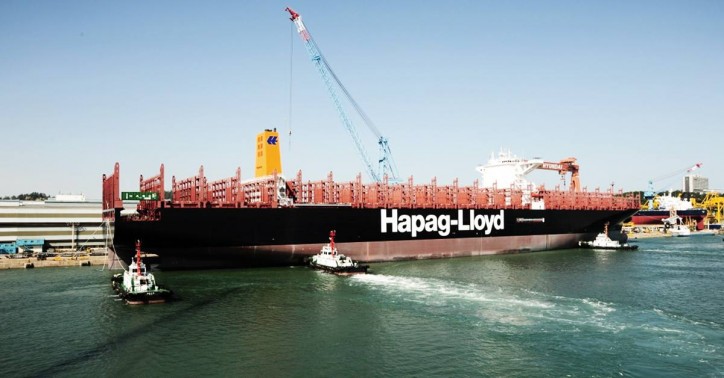Yet another new vessel joins Hapag-Lloyd fleet in South Korea. The 15.000 TEU vessel AFIF was delivered in perfect condition to the Company and is already making its way to Pusan. It's the first ship of this class painted in Hapag-Lloyd colours and design.

By merging with UASC, Hapag-Lloyd is strengthening its position as the fifth-largest liner shipping company in the world. The 230 vessels sailing for the company across the world have a total transport capacity of approximately 1.6 million TEU. The average capacity of the ships is thereby growing by roughly 1,000 TEU, from 5,860 to 6,839 TEU.

However, transport capacity isn’t the only thing growing as a result of the merger. Thanks to the many practically new vessels that UASC is bringing into the combined company, the “new” Hapag-Lloyd will have the youngest fleet among all of its large competitors. As a result of the merger, the average ship age has dropped from 8.5 to 7.2 years . In contrast, the vessels of the 15 leading companies in the sector have an average age of 8.3 years. The many young ships represent a genuine competitive advantage because their modern technology and intelligent design allow them to sail in an especially fuel-efficient manner which also helps minimize emissions.

The fleets of UASC and Hapag-Lloyd are almost a perfect match because both shipping companies had chiefly invested in ships of different sizes in recent years. For example, until now, Hapag-Lloyd did not have any so-called ultra large containers vessels (ULCVs) with capacities of 15,000 TEU or more.
UASC’s “Tihama,” “Al Dahna,” “Al Zubara,” “Al Nefud,” “Al Muraykh” and “Barzan,” which sail for the new THE Alliance in the Far East service between Asia and North Europe, even have a capacity of 19,870 TEU each. Another 10 UASC vessels (including newbuildings delivered in 2017) can take on up to 15,000 TEU. Before the merger, the largest ships in Hapag-Lloyd’s fleet were the 10 “Hamburg Express”-class vessels, each with capacities of around 13,200 TEU.

In recent months, Hapag-Lloyd has also newly launched five “Valparaíso Express”-class vessels: the “Valparaíso Express,” the “Callao Express,” the “Cartagena Express,” the “Santos Express” and the “Guayaquil Express.” The 333-meter-long and 48-meter-wide newbuildings, each of which can transport 10,500 TEU, were specifically designed to meet the requirements of the new Panama Canal and the often rather shallow ports of South America. They will predominantly sail between North Europe and Latin America, and each of them boasts a particularly high reefer capacity, with 2,100 reefer slots. These vessels are a good complement to the seven 9,300 TEU units – the “Cisnes,” the “Coyhaique,” the “Corcovado,” the “Cauquens,” the “Cochrane,” the “Cautin” and the “Copiapo” – that the Chilean shipping company CSAV brought into the fleet when it merged its container activities with Hapag-Lloyd in 2014, and that primarily sail between Asia and the west coast of North America and Latin America.

Yet another special feature of Hapag-Lloyd’s fleet are the five 3,237 TEU ships that sail for Area US Flag under the American flag: the “Philadelphia Express,” the “Washington Express,” the “St. Louis Express,” the “Yorktown Express” and the “Charleston Express.” The vessels transport cargo under contract to the US government. In fact, Hapag-Lloyd is one of only three shipping companies in the world permitted to be active in this business field.
In addition to ultra-large, large and medium-sized vessels, the fleet also include a series of small but powerful vessels for short sea shipping. Last but not least, the smallest charter vessel currently in the fleet is the 868 TEU “Hanna,” and the smallest owned ship is the 1,620 TEU “Mapocho,” which sails under the Chilean flag.
Source: Hapag-Lloyd